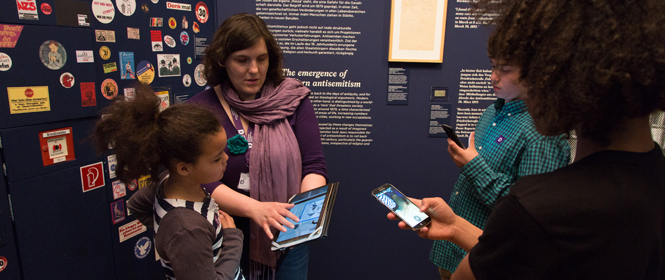
MY PROJECT: MUSEUM FOR ALL
Our Guided Tours Officer Friedrun Portele-Anyangbe tells us about a ‘museum for all’.
Mrs ten Berge confidently heads for the entrance of the special exhibition entitled ‘Sticky Messages’ by following the tactile paving guidance system with her long stick. This is not the first time that the severely visually impaired Dutchwoman has visited Deutsches Historisches Museum. Since a guidance system for visually impaired visitors was first installed for the photographic exhibition ‘The Eyes of War’ in 2014, Deutsches Historisches Museum has been a firm fixture on her cultural programme during her stays in Berlin.
CREATIVITY AND COMMUNICATION
The exhibition, which showcased the photographic portraits of Martin Roemers, marked the start of an inclusive design and presentation system that is accessible to all. Even though the German Disability Equality Act (Behindertengleichstellungsgesetz) was passed in 2002 and the UN Convention on the Rights of Persons with Disabilities came into force in 2008, it was necessary to develop internal standards for inclusive exhibition design. Creativity, testing and, first and foremost, cooperation with the target groups were required.
Just like the image descriptions for the audio guide specially developed for blind and visually impaired people, the guidance system was tested and evaluated several times by associations representing the target group’s interests. These experiences have been used to inform the special exhibition ‘Sticky messages’, which is the museum’s third inclusively designed special exhibition. The approach is more comprehensive than for ‘The Eyes of War’, as Guided Tours Officer Friedrun Portele-Anyangbe explains.
‘We have attempted to make the exhibition both accessible (i.e. wheelchair-friendly) and inclusive. We want to welcome blind and visually impaired people as well as people with learning difficulties. With this in mind, we have set up inclusive communication stations, where the information on selected objects is available on an equal basis in five languages – German, English, Braille, German Sign Language and Plain German. The objects and the models always interact with at least two senses. Visitors can hear, see, touch or smell them. Alongside the tactile paving system, the exhibition offers an audio guide with spoken descriptions in German and English that have been well received amongst all visitors.’
Portele-Anyangbe is already working on the major exhibition on German colonialism, which is set to open its doors on 14 October 2016. Here, the inclusive communication stations will illustrate overarching issues such as everyday racism or the traces of colonialism in urban spaces, thus bringing the topics to life for everyone. This History and Jewish Studies graduate dreams of developing a ‘museum for all’ and bringing complex historiography to life for everyone.